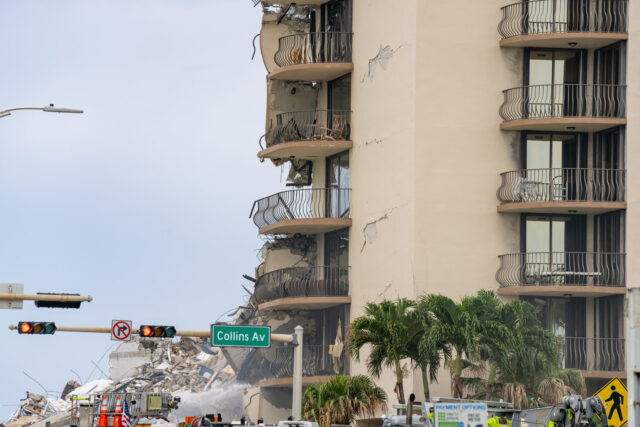The unexplained collapse of a 12-storey Miami unit block has implications for apartment buildings around the world.
At 1.25am EDT on June 24, an apartment complex in Surfside, South Florida known as Champlain Towers South partially collapsed. As of July 9, at least 64 people died in the tragedy and 76 remain missing.
Many factors hampered the two-week search-and-rescue effort, including bad weather, unstable rubble and fires. On July 4, rescuers demolished the remaining section of the building using a controlled explosion due to fears about its stability.
The cause of the collapse remains unknown. Authorities expect the official investigation to take months to complete.
The lack of answers has raised serious concerns about the structural integrity of Champlain Towers North, the adjacent complex built in 1981. Surfside Mayor Charles Burkett described the north tower as “essentially the same building, built by the same developer at the same time with the same plans, probably with the same materials”.
Engineers are conducting a review of the building, which officials considered evacuating in the aftermath of the southern tower’s collapse. “We have some concerns — not just some, but deep concerns about that building,” says Burkett.
Municipal authorities have advised other large apartment blocks in the area to undertake a full structural review of their systems.
An unexpected tragedy
Constructed on reclaimed wetlands, the 12-storey condominium housed 136 apartments. The building fell in three stages: first, the centre of the building collapsed, followed by the north-facing and then the eastern sections. One eyewitness account reported by the BBC suggests the area adjacent to the pool collapsed first.
“Video footage suggests the building experienced a progressive collapse,” Trivess Moore and David Oswald, both senior lecturers in construction at RMIT, write in The Conversation. “This happens when there is failure of a primary structural element, which then causes failure of adjoining members. For example, if one floor can’t support the floors above it, those floors collapse and ‘pancake’ the floors below.”
While several inspections had identified problems with the building’s structure, none had warned of an imminent collapse. “The building was … undergoing a 40-year recertification, as is required in Florida, and early media reports are that this process had not identified any major issue with the building,” note Moore and Oswald.
A 2018 survey flagged a problem with the pool deck’s design that prevented water from draining away. The report by engineer Frank Morabito advised that the worn-out waterproofing beneath the pool deck required replacement and was causing “major structural damage to the concrete structural slab”.
The engineer’s report also identified significant cracking in the underground car-park and recommended urgent concrete repairs, which hadn’t commenced before the building’s collapse.
Why it happened
Speaking to IPWEA, Oswald says “it’s extraordinary that the building suffered a progressive collapse under no apparent extreme event, such as a fire or bomb”.
Many have speculated about the possible causes of the disaster. Structural engineer Greg Batista told the BBC the collapse could be due to ‘spalling’ – where the reinforcing steel inside the concrete rusts, which causes it to expand and crack the surrounding concrete, compromising its integrity. “All it takes is one beam or one column to fail and it causes a domino effect,” he says.
Another theory is that land subsidence contributed to the collapse. A Florida International University study published in Ocean & Coastal Management in 2020 found that areas of Miami Beach, including the reclaimed wetlands where the complex stood, sank at a rate of one to three millimetres per year in the 1990s.
While FIU Institute of Environment Professor Shimon Wdowinski believes land subsidence is unlikely to be the primary cause of the collapse, he says it deserves investigation. “When we measure subsidence or when we see the movement of the buildings, it’s worth checking why it happens,” he notes.
RMIT’s Moore and Oswald point to nearby construction work on the 18-storey tower block Eighty Seven Park: “Investigators will need to consider whether this could have disturbed the foundations. This nearby construction work could have created ground movement under nearby buildings due to vibrations or deep excavations work.”
They also flag repairs made to the complex’s roof, noting “it’s less likely this extra load would have caused the collapse”.
Oswald says: “It’s worth noting that in Australia, there have been examples of structural concerns recently, with the evacuation of the Opal and Mascot Towers in NSW being high-profile examples.”
While distinct “codes, regulations, designs and ways of working” apply to the Champlain Towers South disaster, “once it becomes clear what the causes of the disaster were, the risks of recurrence will become clearer for buildings in the US and … elsewhere, such as Australia”, says Oswald.














